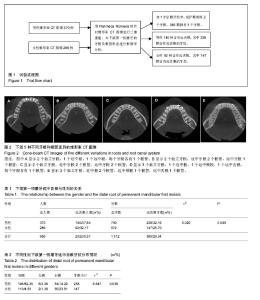| [1] 杨俊,樊明文.根管治疗中常见操作失误[J].中国实用口腔科杂志,2010,3(9):528-531.[2] Dahlberg A. Geographic distribution and origin of dentitions. Int Dent J. 1965;15(3):348-355.[3] Cohen S,Burns RC. Pathways of the pulp[M]. St Louis:CV Mosby,2002:210-211.[4] Cotton TP, Geisler TM, Holden DT, et al. Endodontic applications of cone-beam volumetric tomography. J Endod. 2007;33(9):1121-1132.[5] Abella F, Patel S, Durán-Sindreu F, et al. Mandibular first molars with disto-lingual roots: review and clinical management. Int Endod J. 2012;45(11):963-978.[6] Awawdeh L, Abdullah H, Al-Qudah A.Root form and canal morphology of Jordanian maxillary first premolars. J Endod. 2008;34(8):956-961.[7] Pattanshetti N, Gaidhane M, Al Kandari AM. Root and canal morphology of the mesiobuccal and distal roots of permanent first molars in a Kuwait population--a clinical study. Int Endod J. 2008;41(9):755-762.[8] Omer OE, Al Shalabi RM, Jennings M, et al. A comparison between clearing and radiographic techniques in the study of the root-canal anatomy of maxillary first and second molars. Int Endod J. 2004;37(5):291-296.[9] Tu MG, Huang HL, Hsue SS, et al. Detection of permanent three-rooted mandibular first molars by cone-beam computed tomography imaging in Taiwanese individuals.J Endod. 2009; 35(4):503-507.[10] Arai Y, Hashimoto K,Iwai K,et al. Fundamental Efficiency of Limited Cone-beam X-ray CT (3DX Multi Image Micro CT) for Practical Use. Dental Radiology. 2000;40(2):145-154. [11] Patel S. New dimensions in endodontic imaging: Part 2. Cone beam computed tomography. Int Endod J. 2009;42(6):463-475.[12] da Silveira PF, Vizzotto MB, Liedke GS, et al. Detection of vertical root fractures by conventional radiographic examination and cone beam computed tomography - an in vitro analysis. Dent Traumatol. 2013;29(1):41-46.[13] Sun Y, Luebbers HT, Agbaje JO, et al. Accuracy of upper jaw positioning with intermediate splint fabrication after virtual planning in bimaxillary orthognathic surgery. J Craniofac Surg. 2013;24(6):1871-1876.[14] Kapila S, Conley RS, Harrell WE Jr.The current status of cone beam computed tomography imaging in orthodontics. Dentomaxillofac Radiol. 2011;40(1):24-34.[15] Larson BE. Cone-beam computed tomography is the imaging technique of choice for comprehensive orthodontic assessment. Am J Orthod Dentofacial Orthop. 2012;141(4): 402, 404, 406.[16] Chang ZC, Hu FC, Lai E, et al. Landmark identification errors on cone-beam computed tomography-derived cephalograms and conventional digital cephalograms. Am J Orthod Dentofacial Orthop. 2011;140(6):e289-297.[17] Sievers MM, Larson BE, Gaillard PR, et al. Asymmetry assessment using cone beam CT. A Class I and Class II patient comparison. Angle Orthod. 2012;82(3):410-417.[18] 刘晓静,杨博,郝靖惠,等.西北地区中国人下颌第一恒磨牙牙根根管数目的锥束CT 研究[J].牙体牙髓牙周病学杂志, 2012,22(7): 375-378.[19] 姜楠,周州,周耀,等.华东地区中国人下颌第一恒磨牙根管形态的锥形束CT分析[J].南京医科大学学报, 2013,33(5):693-697.[20] Scott RG,Turner CG II.The Anthropology of Modern Human Teeth. London: Cambridge University Press, 1997.[21] 洪胜君,谭婧泽.牙齿形态特征的演化与变异在人类族群关系研究中的应用[J].现代人类学通讯,2008,2(5):30-35. [22] Curzon ME. Three-rooted mandibular permanent molars in English Caucasians. J Dent Res. 1973;52(1):181.[23] Schäfer E, Breuer D, Janzen S. The prevalence of three-rooted mandibular permanent first molars in a German population. J Endod. 2009;35(2):202-205.[24] Sperber GH, Moreau JL. Study of the number of roots and canals in Senegalese first permanent mandibular molars. Int Endod J. 1998;31(2):117-122.[25] Younes SA, al-Shammery AR, el-Angbawi MF. Three-rooted permanent mandibular first molars of Asian and black groups in the Middle East. Oral Surg Oral Med Oral Pathol. 1990; 69(1):102-105.[26] Turner CG 2nd. Three-rooted mandibular first permanent molars and the question of American Indian origins. Am J Phys Anthropol. 1971;34(2):229-241.[27] Gulabivala K, Aung TH, Alavi A, et al. Root and canal morphology of Burmese mandibular molars. Int Endod J. 2001;34(5):359-370.[28] Loh HS. Incidence and features of three-rooted permanent mandibular molars. Aust Dent J. 1990;35(5):434-437.[29] Curzon ME, Curzon JA. Three-rooted mandibular molars in the Keewatin Eskimo. J Can Dent Assoc (Tor). 1971;37(2): 71-72.[30] Walker RT, Quackenbush LE. Three-rooted lower first permanent molars in Hong Kong Chinese. Br Dent J. 1985;159(9):298-299.[31] Song JS, Choi HJ, Jung IY, et al. The prevalence and morphologic classification of distolingual roots in the mandibular molars in a Korean population. J Endod. 2010; 36(4):653-657.[32] Tu MG, Huang HL, Hsue SS, et al. Detection of permanent three-rooted mandibular first molars by cone-beam computed tomography imaging in Taiwanese individuals. J Endod. 2009; 35(4):503-507.[33] Wang Y, Zheng QH, Zhou XD, et al. Evaluation of the root and canal morphology of mandibular first permanent molars in a western Chinese population by cone-beam computed tomography. J Endod. 2010;36(11):1786-1789.[34] Huang CC, Chang YC, Chuang MC, et al. Evaluation of root and canal systems of mandibular first molars in Taiwanese individuals using cone-beam computed tomography. J Formos Med Assoc. 2010;109(4):303-308.[35] Garg AK, Tewari RK, Kumar A, et al. Prevalence of three-rooted mandibular permanent first molars among the Indian Population. J Endod. 2010;36(8):1302-1306.[36] Yang Y, Zhang LD, Ge JP, et al. Prevalence of 3-rooted first permanent molars among a Shanghai Chinese population. Oral Surg Oral Med Oral Pathol Oral Radiol Endod. 2010; 110(5):e98-e101. [37] 顾永春,周培刚,丁月峰,等.中国西北地区人群恒牙牙根变异的锥束CT观察[J]. 牙体牙髓牙周病学杂志,2011,21(9):499-505.[38] 黎远皋,王继朝,周欣,等.下颌第一磨牙近中三根管的临床研究[J].实用口腔医学杂志,2008,24(3):397-400.[39] 王彬娉,杜永秀,邢莉,等.下颌第一磨牙远中三根管的临床研究[J].海南医学院学报,2009,15(5):492-493.[40] Kottoor J, Sudha R, Velmurugan N.Middle distal canal of the mandibular first molar: a case report and literature review. Int Endod J. 2010;43(8):714-722.[41] Banode AM, Gade V, Patil S, et al. Endodontic management of mandibular first molar with seven canals using cone-beam computed tomography. Contemp Clin Dent. 2016;7(2): 255-257.[42] Jerome CE, Hanlon RJ Jr. Dental anatomical anomalies in Asians and Pacific Islanders. J Calif Dent Assoc. 2007p;35(9): 631-636.[43] Calberson FL, De Moor RJ, Deroose CA. The radix entomolaris and paramolaris: clinical approach in endodontics. J Endod. 2007;33(1):58-63.[44] Holtzmann L. Root canal treatment of a mandibular first molar with three mesial root canals. Int Endod J. 1997;30(6): 422-423.[45] 吴友农,岳保利.1769个恒牙根管系统的形态学研究[J].实用口腔医学杂志,1995,11(2):98-101.[46] Swartz DB, Skidmore AE, Griffin JA Jr. Twenty years of endodontic success and failure. J Endod. 1983;9(5):198-202. [47] Hoen MM, Pink FE. Contemporary endodontic retreatments: an analysis based on clinical treatment findings. J Endod. 2002c;28(12):834-836.[48] Witherspoon DE, Small JC, Regan JD. Missed canal systems are the most likely basis for endodontic retreatment of molars. Tex Dent J. 2013;130(2):127-139. |

